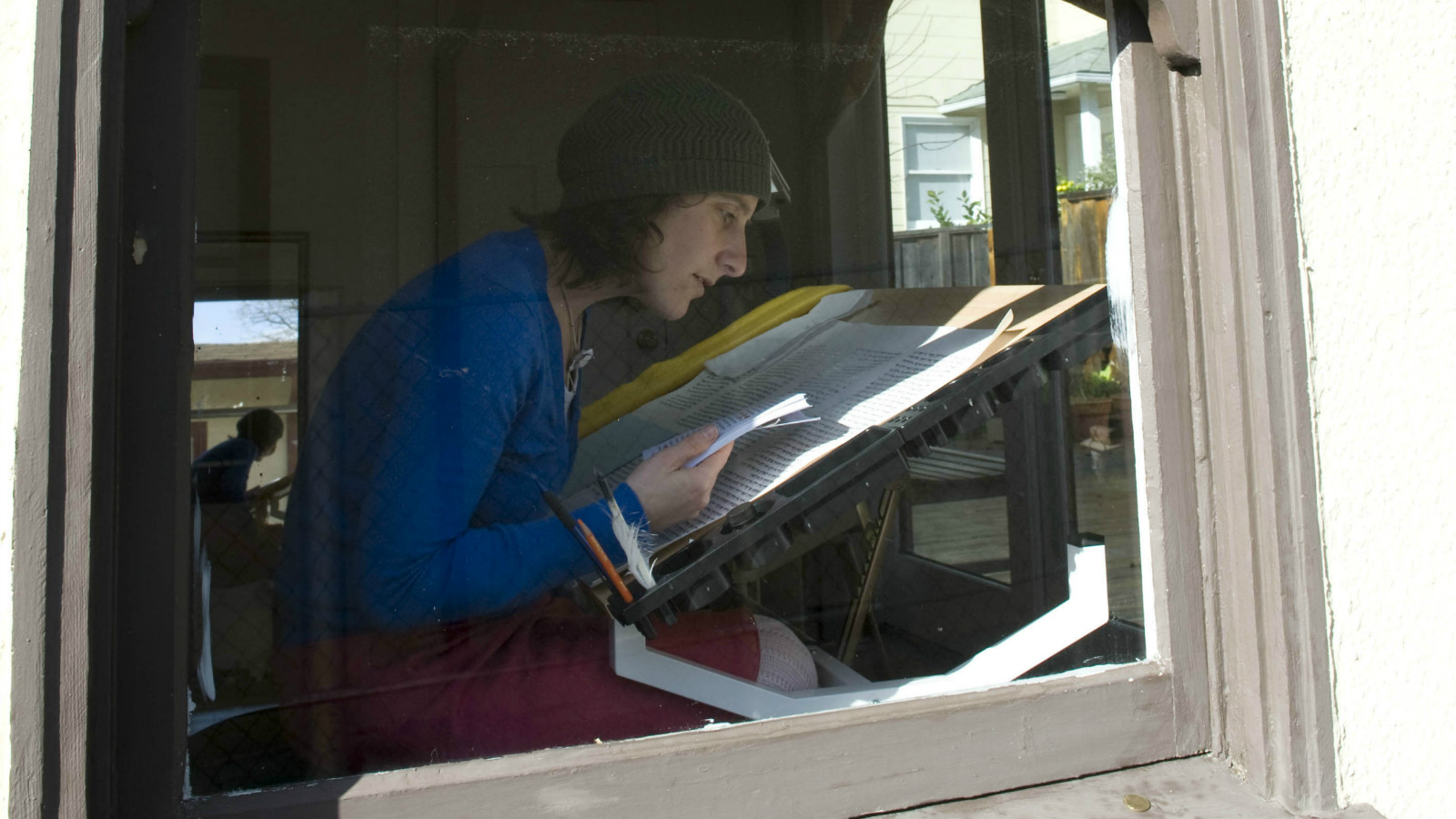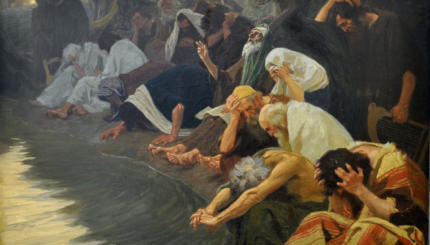Jews have often been called am ha-sefer, the people of the book. This designation underscores the importance of text in Judaism and the belief that God communicates with us through the written word. The central text in Judaism is the Torah. Enhancing the importance of its teachings is the fact that it is written in a special way.
A Religious Act
Writing a Torah scroll is a religious act. First and foremost, a kosher (acceptable according to Jewish law) Torah scroll must be hand-written. This is done by a sofer (scribe), a specially trained individual who is devout and knowledgeable in the laws governing the proper writing and assembling of a scroll. Sofer is from the Hebrew root “to count.” According to the Talmud (Kiddushin 30a), these scholars would count each letter of the Torah. More specifically, the modern scribe is called a sofer stam, an acronym for sefer torah (Torah scroll) tefillin (phylacteries) and mezuzah. All these ritual objects must be written according to strict standards regarding size, lettering style, and layout.
The materials used for creating these sacred items are restricted as well. Parchment used for the writing must be made from the skin of a kosher animal. The scribe mixes a special ink for the writing and prepares the actual writing utensil, a quill, usually from a turkey feather. He uses a reed instrument to scratch lines into the parchment in preparation for the writing. Once all the writing has been completed, the pieces of parchment are sewn together with thread made of animal veins. The finished scroll is attached to wooden rollers. No instrument containing iron or steel may be used in the creation of a Torah scroll, because these metals are used to create instruments of war.
There is a special type of lettering that is used to write the Torah, tefillin, and mezuzah. While the writing looks like a form of Hebrew block letters, certain letters are embellished with crowns, called tagin. The Ashkenazi and Sephardi calligraphic styles vary somewhat, but each group may use the other’s Torah. Greater variations in lettering existed a few hundred years ago. Torah scrolls written by Hasidic groups had swirls in certain letters, with each letter said to convey a mystical meaning. Today, there is greater standardization among Torah scrolls.

Help us keep Jewish knowledge accessible to millions of people around the world.
Your donation to My Jewish Learning fuels endless journeys of Jewish discovery. With your help, My Jewish Learning can continue to provide nonstop opportunities for learning, connection and growth.
The scribe prepares the parchment by scratching 43 horizontal lines on it and two vertical ones at each end. This allows for a standard 42 lines of writing. Each sheet of parchment contains three to eight columns of writing. Certain letters might be stretched within a column to justify the left margin.
There are some places in the Torah where certain letters are larger or smaller than standard, or where the text is written in a different type of column. Each deviation from the norm carries a special meaning. For example, the “Song of the Sea” (Exodus 15:1-19), which describes the parting of the Sea of Reeds, consists of three interlocking columns. The two outer columns symbolize the sea parted on either side, with the middle column representing the children of Israel marching on dry ground. Visually, this sets the section apart from the surrounding columns. Such changes were instituted by the Masoretes — scribes of the 7th-9th centuries who standardized the biblical text — to highlight the importance of certain passages. All of the writing and layout must be done exactly to specification in order for the scroll to be kosher.
Writing a Torah
Writing a Torah scroll is a holy task. In preparation, the scribe immerses in a mikvah (ritual bath). Before beginning a new scroll, he recites a formula declaring his intent to write the scroll for a holy purpose. To make sure all his tools are fit for the task, he tests the quill and ink by writing the word “Amalek” on a piece of parchment. He then crosses it out with a number of strokes in order to fulfill the commandment of blotting out the name of Amalek, a biblical enemy of the Jewish people (Deuteronomy 25:17-19).
The scribe cannot write a Torah scroll from memory, and must refer to a written book called a tikkun (correction guide). Memorization is permitted for the writing of other ritual items. Whenever he writes the name of God, the scribe focuses on the task by declaring out loud his intention to honor God by writing the holy name.
One other ritual item written by a scribe is the megillah (Book of Esther), which is read on Purim. However, in addition to ritual items, scribes also write legal documents such as a get (bill of divorce) or ketubah (marriage contract). The writing of all these items requires strict adherence to traditionally established form. The only place where the scribe has artistic license is in doing calligraphy for and decorating the ketubah. In this instance, creativity fulfills the precept of hiddur mitzvah, enhancing the joyous commandment by beautifying the item associated with fulfilling it.
Who Can Be a Scribe?
The Talmud (Gittin 45b) states that scrolls written by certain groups of people, such as women or minors, cannot be used. The argument is based on an interpretation of Deuteronomy 6:8-9, where instructions are given regarding God’s teachings that you shall bind them on your hand and write them. The traditional understanding of this passage is that only those obligated to bind the teachings on their hand — that is, to wear tefillin — may write a Torah. In other words, being a sofer is restricted to adult Jewish males.
Later commentators relate the obligation to study Torah with the writing of one. This raises the question: since women are not traditionally obligated to study, does this fully prohibit them from writing a Torah, or merely exempt them from it? Today, there is recognition that women do study Torah and so there are those who argue that this permits women to write a Torah scroll. In addition, supporters of this position argue that numerous commentators in the past never put women on the list of those prohibited from fulfilling this sacred task.
The majority of scribes today are Orthodox men, though there are a few female and liberal scribes. It is only in the past few years that a traditionalist woman, Aviel Barclay, has become a scribe, and has been commissioned to write a Torah scroll. This is not without controversy as indicated perhaps by the fact that her teacher chooses to remain anonymous.
A Nascent Movement
The Bible mentions “families of scribes” (I Chronicles 2:5), which were probably schools and guilds where an individual learned through apprenticeship. Modern scribes also learn through individual apprenticeship and receive certification through a professional organization. Interestingly, this is mirrored today in a nascent informal movement of traditionalist women learning this sacred craft secretly and teaching it to each other. This widening of the circle of scribes indicates its central importance for modern Judaism.
kosher
Pronounced: KOH-sher, Origin: Hebrew, adhering to kashrut, the traditional Jewish dietary laws.

Help us keep Jewish knowledge accessible to millions of people around the world.
Your donation to My Jewish Learning fuels endless journeys of Jewish discovery. With your help, My Jewish Learning can continue to provide nonstop opportunities for learning, connection and growth.
sofer
Pronounced: SO-fair (ai as in hair), Origin: Hebrew, a scribe, one who transcribes religious works, especially the Torah.

Help us keep Jewish knowledge accessible to millions of people around the world.
Your donation to My Jewish Learning fuels endless journeys of Jewish discovery. With your help, My Jewish Learning can continue to provide nonstop opportunities for learning, connection and growth.
Talmud
Pronounced: TALL-mud, Origin: Hebrew, the set of teachings and commentaries on the Torah that form the basis for Jewish law. Comprised of the Mishnah and the Gemara, it contains the opinions of thousands of rabbis from different periods in Jewish history.

Help us keep Jewish knowledge accessible to millions of people around the world.
Your donation to My Jewish Learning fuels endless journeys of Jewish discovery. With your help, My Jewish Learning can continue to provide nonstop opportunities for learning, connection and growth.
tefillin
Pronounced: tuh-FILL-in (short i in both fill and in), Origin: Hebrew, phylacteries. These are the small boxes containing the words of the Shema that are traditionally wrapped around one’s head and arm during morning prayers.

Help us keep Jewish knowledge accessible to millions of people around the world.
Your donation to My Jewish Learning fuels endless journeys of Jewish discovery. With your help, My Jewish Learning can continue to provide nonstop opportunities for learning, connection and growth.
Torah
Pronunced: TORE-uh, Origin: Hebrew, the Five Books of Moses.

Help us keep Jewish knowledge accessible to millions of people around the world.
Your donation to My Jewish Learning fuels endless journeys of Jewish discovery. With your help, My Jewish Learning can continue to provide nonstop opportunities for learning, connection and growth.



